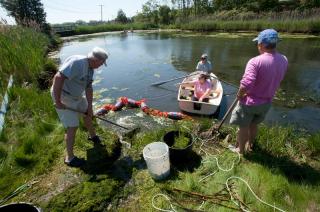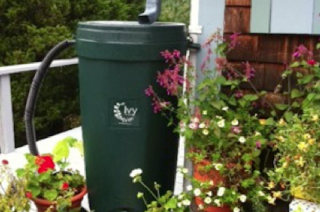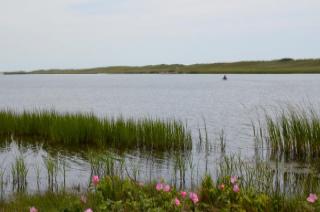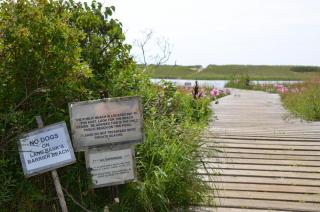A dozen volunteers gathered at the Lagoon Pond last Saturday morning to do something no one could recall being done on the Vineyard. They came to harvest floating mats of algae in Mud Creek in Vineyard Haven. It was both an experiment and a beginning for an expanding effort to manage and improve the water quality in coastal ponds.
Water quality
2013
While nitrogen-rich water can be a boon to plants, it has led to declining water quality and pond health and the disappearance of eelgrass beds. One way to combat the problem, the Lagoon Pond Association says, is to save and reuse nutrient-rich rainwater, thereby preventing it from draining into our ponds.
In an effort to lower nitrogen amounts in Sengekontacket Pond, Edgartown and Oak Bluffs are embarking on a yearly project to grow oysters in the Major’s Cove area of the pond.
In Edgartown, shellfish constable Paul Bagnall told selectmen Tuesday that the shellfish committee is proposing spending $24,000 on 250,000 oyster seed for the pond. The original plan was to spend $48,500 on 500,000 oysters, but the amount was reduced because of the number of articles submitted for town meeting.
2012
A floating raft of plants and flowers bobs atop a pond, quietly removing excess nitrogen.
This is the surface of an aquatic restorer — one of John Todd’s many alternative clean water solutions he described to shellfish constables, harbor masters and others at the Tisbury senior center Thursday evening, in a talk hosted by Tisbury Waterways Inc.
A pair of quahauggers stood waist-deep in Sengekontacket Pond early Thursday morning, the late August sun glinting off the calm water as they raked hardshell clams, perhaps a basketful for their dinner. The pond has been open to summer shellfishing this year for the first time since 2007.
Seth’s Pond in West Tisbury has been reopened for swimming, town board of health agent John Powers confirmed Tuesday morning.
The popular freshwater swimming pond off Lambert’s Cove Road had been closed since July 3 due to high levels of enterococcus bacteria.
On August 9 Mr. Powers said he had five clean water samples that met the state criteria for a geometric mean of levels at or below 33 colony forming units (CFU) per 100 milliliters of water.





